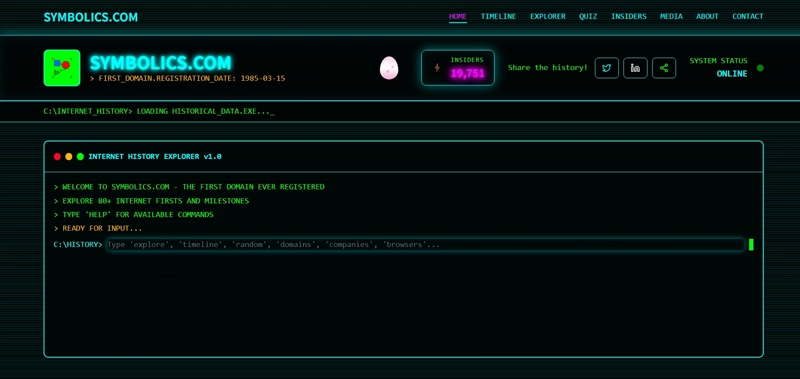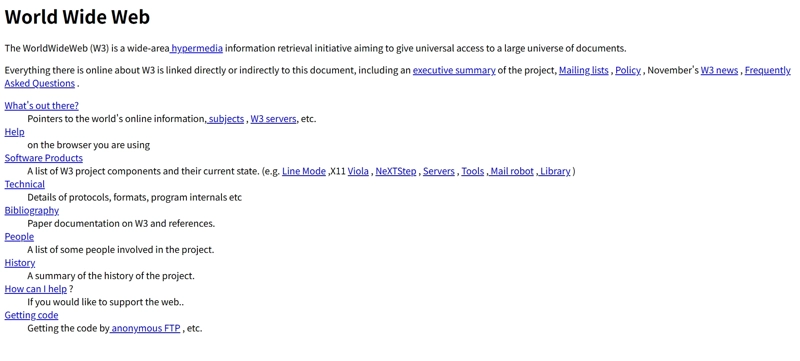On March 15, 1985, in a small lab in Cambridge, Massachusetts, a system administrator typed a simple command:
register symbolics.comPress Enter.
The screen flickered—and the first-ever registered .com domain in history was born.
No applause, no media coverage, not even anyone in the company realized that these few letters would spark a digital revolution.
Today, we click links, type URLs, and build websites every day. But none of this appeared out of thin air. The origins of the internet are hidden in two seemingly ordinary names:
symbolics.com — the first domain
info.cern.ch — the first website
Behind them lie the ideals of scientists, the persistence of engineers, and a quietly transformative technological revolution.
The First Domain: The Unexpected Legacy of symbolics.com
In the early 1980s, the internet was still called ARPANET, a closed network funded by the U.S. Department of Defense, used only by universities and research institutions. At the time, there were no “URLs”; people relied on complicated IP addresses (like ) to reach a host.128.32.16.2
That changed in 1985 when the Domain Name System (DNS) was officially introduced, transforming dull numbers into readable names—like .symbolics.com
The first company to register a domain under this new system was Symbolics Inc., a manufacturer of AI-focused hardware.
They produced a supercomputer called the Lisp Machine, designed specifically to run early AI programs. Their clients included MIT, Stanford, and other top universities.
Registering was simple: it allowed researchers to connect to their servers and download technical documents and software updates.symbolics.com
Little did they know—they had just made history.
Ironically, Symbolics went out of business in the late 1980s due to market decline, but its domain survived.
In 2009, Brewster Kahle, founder of the Internet Archive, purchased and turned it into a digital museum, preserving the history of the internet.symbolics.com
Today, visiting https://www.symbolics.com reveals not product manuals, but a tribute:
“Welcome to the first .com.”

🔍 Fun Fact: The next five .com domains registered after symbolics.com were:
| Date | Domain | Company |
|---|---|---|
| 1985-04-24 | bbn.com | BBN Technologies |
| 1985-05-24 | think.com | Thinking Machines Corp |
| 1985-07-10 | mcc.com | Microelectronics and Computer Technology Corporation |
| 1985-09-19 | dec.com | Digital Equipment Corporation |
Most of these names have faded into history, but symbolics.com remains eternal as the first.
The First Website: Tim Berners-Lee’s “Crazy Idea”
If a domain is the address, the website is the house.
The first person to build this “house” was a quiet, idealistic British programmer—Tim Berners-Lee.
In 1980, he was a software consultant at the European Organization for Nuclear Research (CERN) in Geneva, Switzerland. CERN brought together some of the brightest minds in the world, studying particle physics and exploring the origins of the universe.
But one problem plagued everyone: information was scattered.
Scientists from around the globe used different computers, operating systems, and file formats. Data, drafts, and meeting notes were spread everywhere, making research feel like searching for a needle in a haystack.
One night, Tim had an idea:
“What if I could link all documents together using hypertext?”
He named the project “Enquire Within Upon Everything”, inspired by a Victorian household guide.
Though initially an internal tool, it already contained the core idea of the World Wide Web: clicking links to navigate between documents.
Six years later, in 1989, he formally submitted a proposal titled:
“Information Management: A Proposal”
It began:
“There is a large amount of information being produced, but we lack an effective way to track it… I propose to develop a hypertext-based information management system.”
His supervisor scribbled a note in the margin:
“Vague, but exciting.”
This brief comment would become one of the most famous remarks in internet history.
From Concept to Reality: The First Website Goes Live
On Christmas 1990, Tim completed three revolutionary achievements:
- Created the world’s first web browser (WorldWideWeb)
- Developed the first web server (httpd)
- Built the very first web page
The server sat in the corner of his office on a NeXT computer, labeled:
“This machine is a server. DO NOT POWER IT DOWN.”
On August 6, 1991, he officially made the system accessible to the world, launching the first website:
The page was extremely simple—text-only, no images—covering:
- What the World Wide Web is
- How to create your own webpage
- How to set up a server
- How to use hypertext links
It was essentially an instruction manual, inviting researchers worldwide to join the information-sharing movement.
Within a few years, from UC Berkeley to Helsinki, more and more people were setting up their own websites—the Web had truly begun to weave itself.
Step Back in Time: Explore the “Original” Webpage
The original page no longer exists, but in 2013 CERN launched a project to reconstruct the first website, successfully restoring the 1992 version.
You can experience it yourself here:
👉 http://info.cern.ch/hypertext/WWW/TheProject.html

As you scroll through the plain-text page and click the blue links, you are walking the path Tim laid thirty years ago.
Remarkably, Tim could have patented this technology and become a billionaire. Instead, he made it freely available, ensuring the Web remained open, free, and decentralized.
He famously said:
“The Web is for everyone.”
In 1994, he founded the World Wide Web Consortium (W3C) to maintain web standards. In 2016, he received the Turing Award for inventing the Web.
Summary: Keys and Houses, Ideals and Reality
| Milestone | Date | Significance |
|---|---|---|
| 🗝️ symbolics.com | March 15, 1985 | The internet gained a memorable address, opening the era of commercial networking |
| 🏠 info.cern.ch | August 6, 1991 | A new paradigm for information sharing, marking the birth of the modern website ecosystem |
symbolics.com is the first named place.
is the first true “home.”info.cern.ch
One is a historical accident; the other is deliberate civilization building.
One belongs to commercial pioneers; the other to scientific idealists.
Their intersection made it possible for us to easily register domains, publish blogs, and build e-commerce sites today.
A Lesson for Web Builders
If you are learning to build websites on websitesoez.com, remember:
All great websites start with a simple idea, a line of code, and a single click.
As Tim wrote:
“You should contribute!”
Whether your site sells coffee, hosts a diary, or teaches others to build websites—you are part of this grand history.
